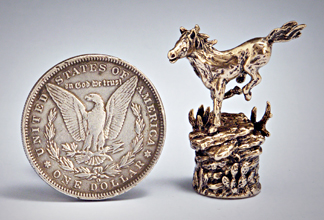
Riccio Thimbles

Riccio Thimbles are cast in bronze using the "lost wax" casting technique.
About Bronze
Bronze is an alloy (mixture) of copper and other metals. Alloying metal is a way to improve its usefulness. Bronzes are mixed in many different variations which can effect strength, workability, and color. The knowledge and use of bronze in making things has been a part of civilization for thousands of years. Because of its beauty, durability and workability it has always been the metal of choice for making great works of art. I make thimbles as works of art. In keeping with tradition, I make them in bronze.
Making a New Design
When I design a new thimble, I must first make a model of it in wax. Model making is a meticulous step by step process that can take many hours. I use a variety of waxes that have different properties. Some waxes are hard and can be carved with tiny knives as one would carve wood. Other waxes are pliable, like toffee, and can be shaped with your fingers into flowing forms such as flowers. All waxes can be heated and melted together. Many simple parts can be joined to become a complex structure. The creative possibilites are infinite. Much effort is put into the concept and design before the model making begins. Sometimes, I will work on an idea for months before it reaches the work table. For more information about the philosophy of how I design my thimbles you can look at About Riccio Thimbles in this section of the web site.
The
Casting Process
When a wax model is finished, I add wax rods that will hold the model up
and become channels in the mold. These channels are called gates. This
assembly
is placed
into
an empty stainless steel container about the size and shape of a
coffee can. I then mix a plaster like “investment” powder with
water to a consistency of pancake batter. I pour this into the container until
the model
is covered.
In ten minutes the investment begins to harden. We now have a mold. The mold
is then heated in a furnace to 1325°F. Inside the mold, the wax model melts
and flows out through the gates. The resulting cavity inside the mold is the
exact imprint of the original model, and the gates are now empty pathways.
This technique is commonly called the “lost wax process”.
Now the mold is ready to receive bronze. I heat my bronze to around 2000°. At this temperature it is a thick liquid. I line up my crucible so that the bronze can enter the same pathways that the wax streamed out. To achieve the fine detailing of my castings, bronze is not simply poured, but forced with great pressure into the mold, using a very large centrifuge. After the metal has been injected, the mold is left to cool until it can be handled. To free the casting inside, the mold is hammered to break apart the investment. The metal gates are cut off and the casting is thoroughly cleaned and sanded. Polishing brings out the highlights and reveals the beauty of the metal. Various patinas are also applied to enhance or color the background. The casting is completed by a second polishing. Finally a lacquer may be applied to preserve the finish.